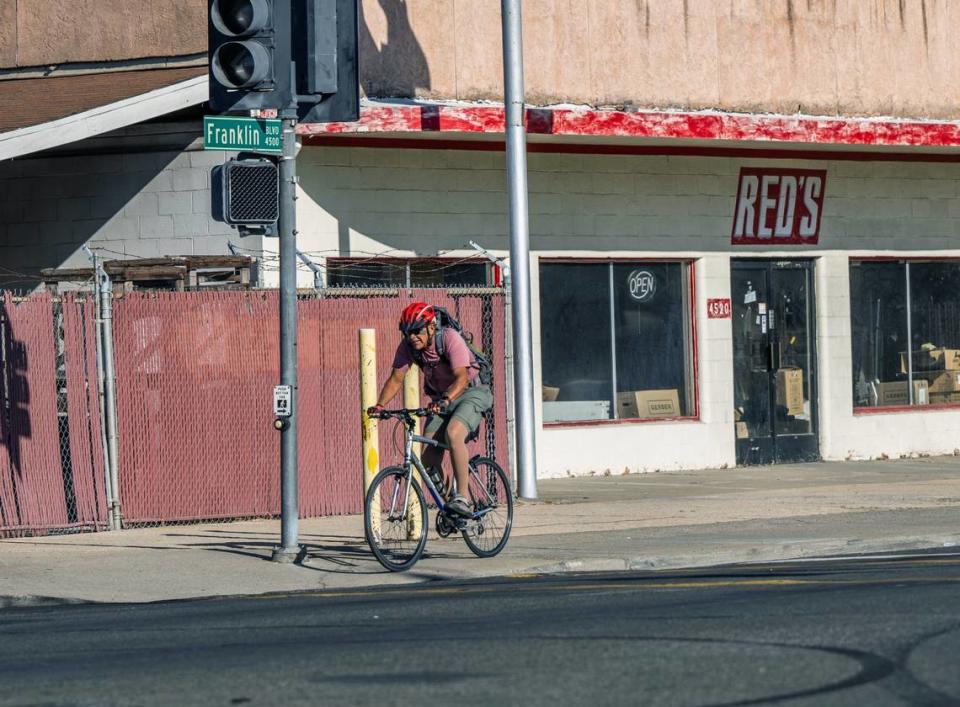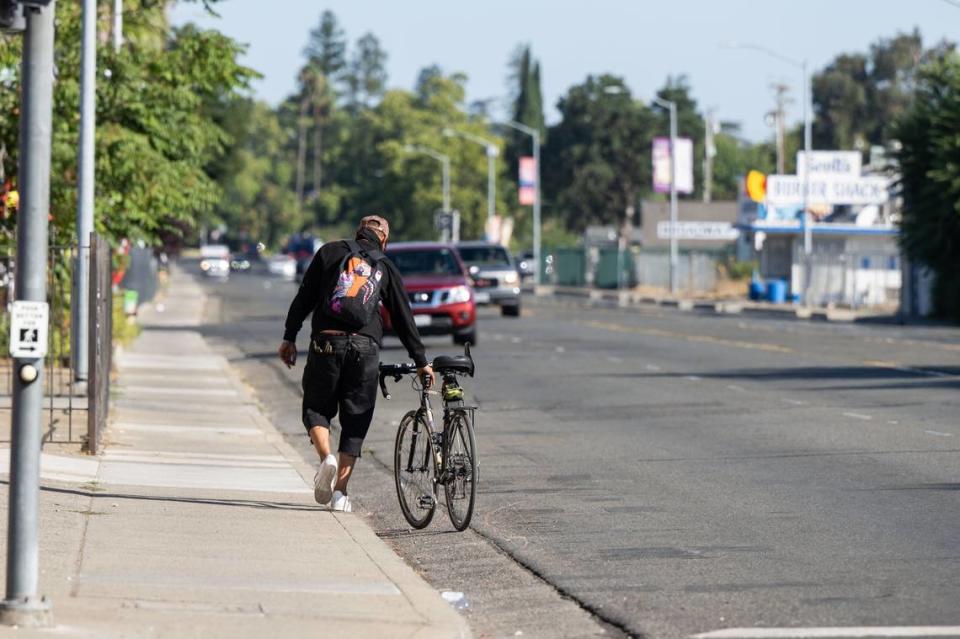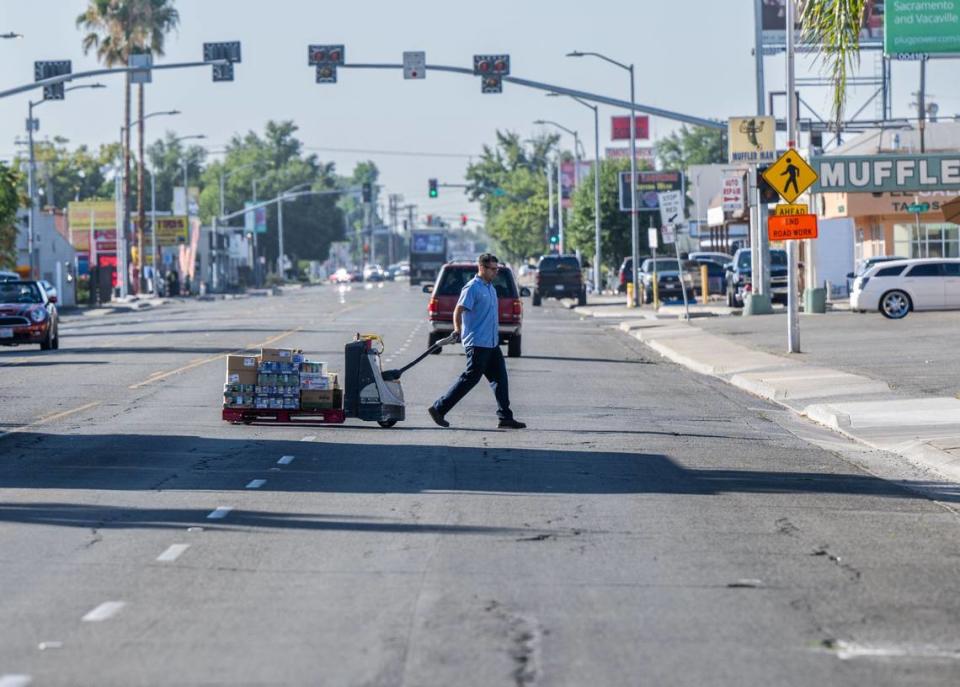Sacramento is installing bike lanes to help meet California climate goals. Here’s how it works
Climate change is global but the actions we take here in Sacramento play a role in shaping our environmental future. The Sacramento Bee is undertaking a collaboration with you to examine and celebrate bold and ambitious climate actions that have yielded evidence that they’re making progress here and elsewhere. The goal is to engage you and your neighbors in a hopeful discussion about how we can face climate change with urgency and equity.
Local artists designed the murals that flank a cyclist’s ride down Franklin Boulevard. Community members painted the monarch butterflies, vintage cars and portraits of Hispanic men and women who reflect the area’s deep-rooted Latino heritage. Hungry riders have options: a taqueria or a bakery with cases full of sweet conchas.
But on a summer day, the sun beats down, unobstructed by a tree canopy. In fact, there are no green spaces at all. There’s no bike lane, and cracks in the narrow sidewalk make the ride bumpy. Crossing the street is challenging, as few and far between designated crosswalks push cyclists to find a break between speeding cars.
At first glance, Franklin Boulevard seems like the perfect place to commute via bike, as does the rest of Sacramento. The city has warm weather, no snow and a flat terrain. What more do you need?
As it turns out, a lot. People in the region are heavily car dependent. More than half of Sacramento’s greenhouse gas emissions, according to 2016 data included in a report by the Sacramento Mayor’s Commission on Climate Change, come from the transportation sector.
California Gov. Gavin Newsom signed into law last year a climate goal to achieve net-zero greenhouse gas emissions by 2045. The Sacramento County Board of Supervisors set a goal a few years ago to be carbon neutral by 2030, but has since discussed changing their target to 2045 in line with the state’s guidelines.
The city of Sacramento is also aiming for carbon neutrality by 2045, and is relying on increasing active transportation, such as walking or biking, to be a pillar in their reduction goals.
In order to reach net-zero carbon, the mayor’s commission noted that active transportation has to be a “safe and attractive” option, supported by reliable “pedestrian-centric” infrastructure throughout the city. This might involve widening sidewalks, adding more frequent crosswalks or installing sufficient and secure bike parking, protected bike lanes and street lighting.
“The potential of reducing emissions by increasing active transportation is undeniable,” the report reads. “This strategy is focused on (...) creating a seamless network of active transportation corridors and providing basic amenities at the neighborhood level so that shorter trips can be taken by walking or rolling to meet daily needs.”

By the community, for the community — whether cyclist, walker or driver
One idea that’s gained popularity in the world of city planning is a design approach known as “complete streets.” Complete streets are created to be safe and convenient for users of all modes of transportation.
In the city of Sacramento, several projects like this are underway: One of these is the Franklin Boulevard Complete Street project in the North City Farms and South Oak Park neighborhoods.
Megan Johnson, a senior engineer with the city’s public works department, said that the project is wrapping up its final design phase and targeting construction in the summer of 2024. Plans include switching out two of the car lanes for separated bike lanes, widening the sidewalk, planting shade trees and adding pedestrian crossings and better street lighting.
“People want to be able to walk to restaurants, to the supermarket, or they want to be able to ride bikes with their family to get there,” Johnson said. “This project is going to reclaim Franklin Boulevard to better serve the people who live around there and work around there.”
Johnson mentioned that one of the things she’s hoping the project will do is bolster local businesses. The way that she described it, when people feel safe and comfortable being out and about on sidewalks, they’re likely to spend more time in the area, stopping by restaurants, shops and services along the street.
The research agrees — multiple studies have found that making cities more walkable and bikeable can boost the local economy. This might help serve as a justification for the cost of the infrastructure, which is often cited as a roadblock to these types of projects.
The Franklin Boulevard project gained funding from a variety of sources, according to Johnson, including federal funds through the Sacramento Area Council of Governments and the Department of Housing and Urban Development, state funds provided by the California Transportation Commission and some local funds.

The city’s plan for the project, Johnson said, was partly constructed based on community feedback. Their team partnered with community organizations and tabled at local events to hear about peoples’ experience as pedestrians in the South Oak Park and North City Farms neighborhoods, and how they might want that experience to change. She also highlighted that the project built off work that the Franklin Boulevard Business Association began years earlier to identify where the street might benefit from investment.
“This project was initiated by the community,” Johnson said. “And so, you know, I really hope that it has a tremendous beneficial impact for the community.”
How bikeability aligns with health and equity
Sacramento County air quality has previously failed to meet certain federal health standards for pollutants associated with increased risk of asthma, according to a SACOG report.
Jennifer Finton, the CEO of lung health advocacy group Breathe California Sacramento, said this is partly because of vehicle emissions — and that replacing those vehicles with bikes could make a big difference for local air quality.
Finton said that her organization often partners with biking or pedestrian advocacy groups, backing bike lanes from the standpoint that “taking cars off the road and replacing them with bikers or walkers improves both greenhouse gas emissions and air pollution.”
And it’s not just about lung health — several studies have found a correlation between better walkability in a neighborhood and lower frequency of obesity, Type 2 diabetes and high blood pressure. Active transportation has also been linked to improved mental health, including lower levels of stress and anxiety.
Kiara Reed, the executive director of equitable environmental design organization Civic Thread, said that when it comes to bike and pedestrian safety, it’s important to pay attention to the intersection of ideas, “instead of siloing them off.”
Reed said that one intersection between community health and environmental design is tree shade, which is increasingly important to the feasibility of biking and health of cyclists, as Sacramento faces hotter and hotter summers.
Although Sacramento is well-known for its extensive tree canopy, the shade isn’t evenly distributed. Areas like South Oak Park and North City Farms, where the Franklin Boulevard project is taking place, have around 20-22% of their land covered with trees, as compared to about 30% in midtown and even higher concentrations in East Sacramento and Land Park.
Planting trees is a key part of the plan for revitalizing Franklin Boulevard, according to Johnson, who said she hopes the added shade has a big impact on the comfort of bikers in the area.
A solution several years in the making — and it’s still not perfect
The process of planning for the Franklin Boulevard transformation and applying for grants began in 2017, and while the first piece of the project is slated to begin construction next year, the second half is still in the process of securing funding.
A long timeline like this isn’t uncommon for complete street projects, or construction projects in general, according to Johnson. Making these changes is a lot more complicated than it first appears. While funding isn’t the only limiting factor, it’s certainly one of the main factors that could be holding Sacramento residents back from being able to make the switch from four wheels to two.

One of the biggest hazards of urban biking is bike theft. Nearby in Davis, hundreds of bikes are stolen each year, while thousands of bikes are reported stolen in San Francisco annually.
Deb Banks, the executive director of the Sacramento Area Bicycle Advocates, suggested solutions such as low-cost bike lockers, education on secure bike locks or free “valet bike parking” either at bike shops like those in Berkeley or hosted by groups like SABA at local events. Sacramento already has some bike lockers, but expanding these ideas would require either willing volunteers, funding for infrastructure, or both.
And advocates like Reed may dream of a “15-minute city,” where basic necessities and locations, such as a grocery store, a park, a school and a resident’s job, can all be reached by a 15-minute walk or bike ride from anywhere in the city — but without sufficient funds, the infill development required to make that a reality isn’t possible.
Infill development is the opposite of urban sprawl. It involves using empty or underutilized pieces of land within urban areas that are already largely developed. This could mean adding affordable housing to areas that already have retail development. But according to Finton, it has one problem: “It’s incredibly expensive to make some of these changes.”
“If we want people to be able to not have a car, then we don’t want them to be priced out of living in an area where they don’t have to have a car,” Banks said. “So how do you then bring affordable housing into the mix?”
SACOG set a goal in their 2020 Sustainable Communities Strategy to prioritize infill housing — their answer for how to do that is a multi-year pilot called Green Means Go, which directs state funding to projects that create more infill housing. The project has located “Green Zones” within centers, corridors or established communities in the Sacramento region. This currently includes the River District, the Railyard and many other neighborhoods in the city of Sacramento, as well as other parts of Sacramento County.
In March of 2023, $31.3 million in Green Means Go grants were approved by the SACOG board of directors for projects in Auburn, Citrus Heights, Rancho Cordova, the City of Sacramento, the City of West Sacramento and more, including multiple affordable housing projects in Sacramento.
But even if the 15-minute-city dream came true, the Sacramento region is also a hub that people commute to and from on long car journeys, and hundreds of thousands of commercial trucks drive through the nearby Interstate 5 corridor each year. In short, there’s a lot of non-local traffic that couldn’t necessarily be replaced with active transportation.
Even for locals, the city can take an hour or more to bike across. Sacramento might have a fairly mild climate, but cyclists still have to contend with rain, wind and fog, and without the comfort of air conditioning and heating and access to the radio, people choosing to bike rather than drive are also going to be choosing some degree of inconvenience, no matter how safe and simple bike infrastructure is.
Active transportation is likely to never be a perfect solution, but Banks believes it’s worth the investment — and so, she said, is investment in public transportation, e-bikes and roads. In other words, cycling doesn’t have to be the only option, but it should be a viable one.
“Why shouldn’t we?” Banks said. “As the capital of the state of California, the seventh largest economy in the world, why shouldn’t our city be great for all forms of users? Pedestrians, cyclists, scooters, skaters, walkers, car drivers — the whole nine yards.”
This story is made possible, in part, with support from the Solutions Journalism Network .

